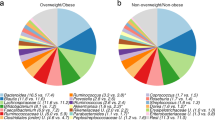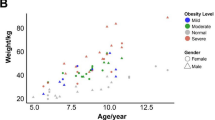Abstract
Objective
Childhood obesity is a major health concern worldwide. Previous studies have explored the relationship between obesity and gut microbiota. However, the results from such studies remain contradictory.
Methods
In the present nested case-control study, based on a twin birth cohort study, the relationship between gut microbiota diversity and overweight/obesity in 1- and 6-month-old infants was explored. Twins were enrolled when one child had normal weight and the other child was overweight/obese at six months old. For both infants, stool samples were collected at 1 and 6 months of age. Finally, 12 twins were enrolled in the study. The gut microbiota was identified by 16S rRNA gene sequencing in the V3–V4 area. Six of the twins were monozygotic.
Results
The results revealed that the microbiota communities of monozygotic twins were similar to those of dizygotic twins. The relative abundance (RA) of microbiota of 1-month-old twins was significantly higher than that of 6-month-old twins. However, the microbiota diversity of 1-month-old twins was significantly lower than that of 6-month-old twins. In addition, 6-month-old twins had significantly higher RA levels of Bifidobacterium and Lachnospiracea incertae sedis than 1-month-old twins. The 6-month-old group had significantly lower RA levels of Veillonella, Klebsiella, Akkermansia, Streptococcus, or Staphylococcus than the 1-month-old group. At six months, the RA level of Clostridium sensu stricto was higher in the overweight/obesity group than the normal-weight group.
Conclusion
These findings imply that changes in gut microbiota diversity during infancy may contribute to the development of obesity in early infancy.
Similar content being viewed by others
References
GBD 2016 Risk Factor Collaborators. Global, regional, and national comparative risk assessment of 84 behavioral, environmental and occupational, and metabolic risks or clusters of risks, 1990–2016: a systematic analysis for the Global Burden of Disease Study. Lancet, 2017,390:1345–1422
Woo BJ, Locks LM, Cheng ER, et al. Risk Factors for Childhood Obesity in the First 1,000 Days: A Systematic Review. Am J Prev Med, 2016,50(6):761–779
Visconti A, Le Roy CI, Rosa F, et al. Interplay between the human gut microbiome and host metabolism. Nat Commun, 2019,10(1):4505
Lynch SV, Pedersen O. The Human Intestinal Microbiome in Health and Disease. N Engl J Med, 2016,375(24):2369–2379
Backhed F, Roswall J, Peng Y, et al. Dynamics and Stabilization of the Human Gut Microbiome during the First Year of Life. Cell Host Microbe, 2015,17(6):852
Gregory KE, Samuel BS, Houghteling P, et al. Influence of maternal breast milk ingestion on acquisition of the intestinal microbiome in preterm infants. Microbiome, 2016,4(1):68
Madan JC, Salari RC, Saxena D. et al. Gut microbial colonization in premature neonates predicts neonatal sepsis. Arch Dis Child Fetal Neonatal Ed, 2012,97(6):F456–462
Scheepers LE, Pender J, Mbakwa CA, et al. The intestinal microbiota composition and weight development in children: the KOALA Birth Cohort Study. Int J Obes (Lond), 2015,39(1):16–25
Vael C, Verhulst SL, Nelen V, et al. Intestinal microflora and body mass index during the first three years of life: an observational study. Gut Pathog, 2011,3(1):8
Kalliomaki M, Collado MC, Salminen S, et al. Early differences in fecal microbiota composition in children may predict overweight. Am J Clin Nutr, 2008,87(3):534–538
Thursby E, Juge N. Introduction to the human gut microbiota. Biochem J, 2017,474(11):1823–1836
Cho I, Yamanishi S, Cox L, et al. Antibiotics in early life alter the murine colonic microbiome and adiposity. Nature, 2012,488(7413):621–626
Hur YM, Craig JM. Twin registries worldwide: an important resource for scientific research. Twin Res Hum Genet, 2013,16(1):1–12
Zhao J, Yang S, Peng A, et al. The Wuhan Twin Birth Cohort (WTBC). Twin Res Hum Genet, 2017,20(4):355–362
De Onis M, Garza C, Onyango AW, et al. WHO growth standards for infants and young children. Arch Pediatr, 2009,16(1):47–53
Krebs NF, Himes JH, Jacobson D, et al. Assessment of child and adolescent overweight and obesity. Pediatrics, 2007, 120Suppl 4:S193–228
Jones AD, Ickes SB, Smith LE, et al. World Health Organization infant and young child feeding indicators and their associations with child anthropometry: a synthesis of recent findings. Matern Child Nutr, 2014, 10(1):1–17
Magoc T, Salzberg SL. FLASH: fast length adjustment of short reads to improve genome assemblies. Bioinformatics, 2011,27(21):2957–2963
Dong LN, Wang JP, Liu P, et al. Faecal and mucosal microbiota in patients with functional gastrointestinal disorders: Correlation with toll-like receptor 2/toll-like receptor 4 expression. World J Gastroenterol, 2017, 23(36):6665–6673
Dogra S, Sakwinska O, Soh SE, et al. Dynamics of infant gut microbiota are influenced by delivery mode and gestational duration and are associated with subsequent adiposity. MBio, 2015, 6(1):e02419–14
Luoto R, Kalliomaki M, Laitinen K, et al. Initial dietary and microbiological environments deviate in normal-weight compared to overweight children at 10 years of age. J Pediatr Gastroenterol Nutr, 2011,52(1):90–95
Udaondo Z, Duque E, Ramos JL. The pangenome of the genus Clostridium. Environ Microbiol, 2017,19(7):2588–2603
Shang H, Sun J, Chen YQ. Clostridium Butyricum CGMCC0313.1 Modulates Lipid Profile, Insulin Resistance and Colon Homeostasis in Obese Mice. PLoS One, 2016,11(4):e154373
Zhao X, Guo Y, Liu H, et al. Clostridium butyricum reduces lipogenesis through bacterial wall components and butyrate. Appl Microbiol Biotechnol, 2014,98(17): 7549–7557
Yatsunenko T, Rey FE, Manary MJ, et al. Human gut microbiome viewed across age and geography. Nature, 2012,486(7402):222–227
Tamburini S, Shen N, Wu HC, et al. The microbiome in early life: implications for health outcomes. Nat Med, 2016,22(7):713–722
Goodrich JK, Waters JL, Poole AC, et al. Human genetics shape the gut microbiome. Cell, 2014,159(4):789–799
Blekhman R, Goodrich JK, Huang K, et al. Host genetic variation impacts microbiome composition across human body sites. Genome Biol, 2015,16(1):191
Acknowledgments
We thank the participants who enrolled in the study. We also acknowledge our colleagues who assisted in the anthropometric measurements and data collection.
Author information
Authors and Affiliations
Corresponding author
Ethics declarations
The authors declare no conflict of interest.
Additional information
This study was supported by grants from the National Natural Science Foundation of China (No. 81903332) and the Applied Frontier Project of Wuhan Municipal Science and Technology Bureau (No. 2019020701011488).
Rights and permissions
About this article
Cite this article
Mei, H., Li, N., Zhang, Y. et al. Gut Microbiota Diversity and Overweight/Obesity in Infancy: Results from a Nested Case-control Study. CURR MED SCI 42, 210–216 (2022). https://doi.org/10.1007/s11596-021-2476-1
Received:
Accepted:
Published:
Issue Date:
DOI: https://doi.org/10.1007/s11596-021-2476-1




